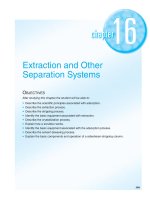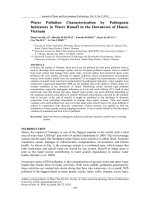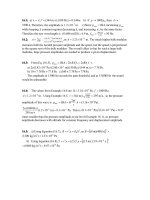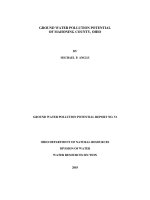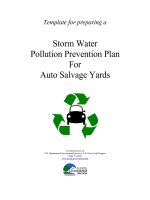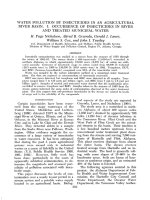Environmental Geology - Chapter 16: Water Pollution
Bạn đang xem bản rút gọn của tài liệu. Xem và tải ngay bản đầy đủ của tài liệu tại đây (3.46 MB, 47 trang )
Environmental Geology
Environmental Geology
Chapter 16
Chapter 16
Water Pollution
Overview
Overview
•
General Principles
•
Industrial Pollution
•
Organic Matter
•
Agricultural Pollution
•
Reversing the Damage–Surface Water
Overview (cont.)
Overview (cont.)
•
Groundwater Pollution
•
Reversing the Damage–Ground Water
General Principles
General Principles
•
Geochemical Cycles
•
Residence Time
•
Residence Time and Pollution
•
Point and Nonpoint Pollution Sources
Water Pollution
Figure CO16
16-1
Source:Courtesy of Carla W. Montgomery.
Residence Time
•
Residence time is the average length of time a
component remains in a system; for natural
substances at equilibrium, residence time equals
capacity divided by rate of influx. For most
substances in seawater, capacity is controlled by
solubility. The element is weathered or leached out
into streams and transported into the ocean, where
it remains until it is precipitated out into
sediments. (This is a very simple case.)
Point and Nonpoint
Pollution Sources
Figure 16.2
16-2
Source: After USDA Soil Conservation Service.
•
Most often, human activities increase the
rate-of-influx term, either by dumping of
concentrated wastes or through
accelerated weathering, as of mine
tailings.
Industrial Pollution
Industrial Pollution
•
Inorganic Pollutants–Metals
•
Other Inorganic Pollutants
•
Organic Compounds
•
Problems of Control
•
Thermal Pollution
Heavy Metals
What characteristic of the so-called heavy
metals causes them to be especially
hazardous to humans and other animals
high in food chains?
•
The heavy metals accumulate in the body;
they are not readily excreted. Therefore,
their concentrations tend to increase going
up a food chain.
Acid Mine Drainage
Figure 16.3
16-3
Source: Photograph courtesy USGS Photo Library, Denver, CO.
Arsenic in U.S. Ground Water
Figure 16.5
16-4
Source: After USGS Fact Sheet 063-00.
Organic Matter
Organic Matter
•
Nature and Impacts
•
Biochemical Oxygen Demand
•
Eutrophication
Use of DDT Still Present in Fish Tissues
Figure 16.7A
16-6
Source: U.S. Geological Survey Circular 1225.
Harmful health effects of organic
compounds
•
The main problem is that there are so many
synthetic organics and that we know so little
about the toxicity of the vast majority of
them. (It has also been discovered that
many are toxic in very low concentrations
and are persistent in the environment.)
Detection of Pesticides in Urban & Ag Areas
Figure 16.6A
16-5
Source: USGS Pesticides National Synthesis Project, 2000.
BOD (biochemical oxygen demand)
•
BOD, or biochemical oxygen demand, is the
amount of oxygen that would be required to break
down the organic matter in the water aerobically.
The higher the BOD, the lower the dissolved
oxygen concentration tends to be. Just below an
organic-waste source, there will be a drop (“sag”)
in dissolved-oxygen concentration, reflecting
increased BOD. Oxygen levels will be restored
downstream through reaeration and waste decay.

